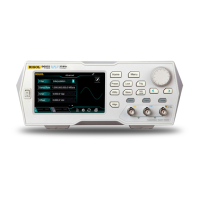RIGOL Chapter 2 Front Panel Operations
2-36 DG800 User's Guide
How to realize the intermodulation between dual channels? The
following example takes the output signal of CH2 as the modulating
waveform.
1. Connect the CH2 output terminal to the rear-panel [CH1/Sync/Ext
Mod/Trig/FSK] connector by using the dual BNC cable.
2. Select CH1, then press Menu Modulation to select the desired
modulation type and set the corresponding parameters. After that, select the
external modulation source.
3. Select CH2 and set the desired modulating waveform and the corresponding
parameters.
4. Press Output1 to enable the output of CH1.
To Set Modulating Waveform Frequency
When the internal modulation source is selected, tap the Mod.Freq parameter input
field, use the numeric keypad to input the modulating waveform frequency.
You can also use the arrow keys and the knob to input a desired frequency
value.
The modulating waveform frequency ranges from 2 mHz to 1 MHz, and the
default value is 100 Hz.
Note: When the external modulation source is selected, this menu will be grayed out
and disabled.
To Set the Modulation Depth
Modulation depth indicates the amplitude variation. It is expressed in percentage.
The AM modulation depth ranges from 0% to 120%. Tap the Mod.Depth parameter
input field to set the AM modulation depth.
At 0% depth, the output amplitude is half of the carrier waveform amplitude.
At 100% depth, the output amplitude is equal to carrier waveform amplitude.
At >100% depth, the output amplitude of the instrument will not exceed 10 Vpp
(into a 50 Ω load).
When the external modulation source is selected, the output amplitude of the
instrument is controlled by the ±5 V signal level of the rear-panel [CH1/Sync/Ext
Mod/Trig/FSK] connector. For example, if the modulation depth is set to 100%,
the output amplitude will be the maximum when the modulating signal is +5 V and
the minimum when the modulating signal is -5 V.

